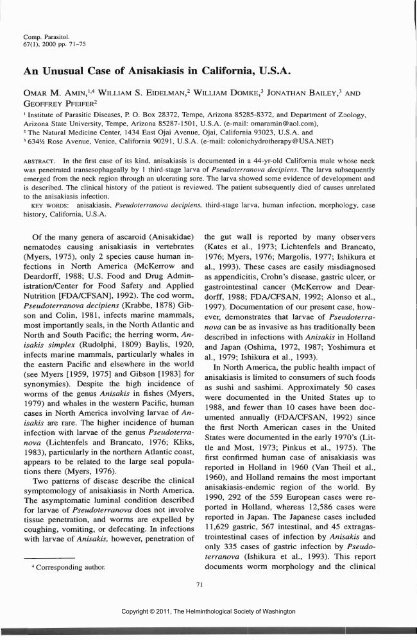Comparative Parasitology 67(1) 2000 - Peru State College
Comparative Parasitology 67(1) 2000 - Peru State College
Comparative Parasitology 67(1) 2000 - Peru State College
You also want an ePaper? Increase the reach of your titles
YUMPU automatically turns print PDFs into web optimized ePapers that Google loves.
Comp. Parasitol.<br />
<strong>67</strong>(1), <strong>2000</strong> pp. 71-75<br />
An Unusual Case of Anisakiasis in California, U.S.A.<br />
OMAR M. AMIN,M WILLIAM S. EiDELMAN,2 WILLIAM DoMKE,3 JONATHAN BAILEY,3 AND<br />
GEOFFREY PFEiFER2<br />
1 Institute of Parasitic Diseases, P. O. Box 28372, Tempe, Arizona 85285-8372, and Department of Zoology,<br />
Arizona <strong>State</strong> University, Tempe, Arizona 85287-1501, U.S.A. (e-mail: omaramin@aol.com),<br />
2 The Natural Medicine Center, 1434 East Ojai Avenue, Ojai, California 93023, U.S.A. and<br />
3 634V2 Rose Avenue, Venice, California 90291, U.S.A. (e-mail: colonichydrotherapy@USA.NET)<br />
ABSTRACT. In the first case of its kind, anisakiasis is documented in a 44-yr-old California male whose neck<br />
was penetrated transesophageally by 1 third-stage larva of Pseudoterranova decipiens. The larva subsequently<br />
emerged from the neck region through an ulcerating sore. The larva showed some evidence of development and<br />
is described. The clinical history of the patient is reviewed. The patient subsequently died of causes unrelated<br />
to the anisakiasis infection.<br />
KEY WORDS: anisakiasis, Pseudoterranova decipiens, third-stage larva, human infection, morphology, case<br />
history, California, U.S.A.<br />
Of the many genera of ascaroid (Anisakidae)<br />
nematodes causing anisakiasis in vertebrates<br />
(Myers, 1975), only 2 species cause human infections<br />
in North America (McKerrow and<br />
Deardorff, 1988; U.S. Food and Drug Administration/Center<br />
for Food Safety and Applied<br />
Nutrition [FDA/CFSAN], 1992). The cod worm,<br />
Pseudoterranova decipiens (Krabbe, 1878) Gibson<br />
and Colin, 1981, infects marine mammals,<br />
most importantly seals, in the North Atlantic and<br />
North and South Pacific; the herring worm, Anisakis<br />
simplex (Rudolphi, 1809) Baylis, 1920,<br />
infects marine mammals, particularly whales in<br />
the eastern Pacific and elsewhere in the world<br />
(see Myers [1959, 1975] and Gibson [1983] for<br />
synonymies). Despite the high incidence of<br />
worms of the genus Anisakis in fishes (Myers,<br />
1979) and whales in the western Pacific, human<br />
cases in North America involving larvae of Anisakis<br />
are rare. The higher incidence of human<br />
infection with larvae of the genus Pseudoterranova<br />
(Lichtenfels and Brancato, 1976; Kliks,<br />
1983), particularly in the northern Atlantic coast,<br />
appears to be related to the large seal populations<br />
there (Myers, 1976).<br />
Two patterns of disease describe the clinical<br />
symptomology of anisakiasis in North America.<br />
The asymptomatic luminal condition described<br />
for larvae of Pseudoterranova does not involve<br />
tissue penetration, and worms are expelled by<br />
coughing, vomiting, or defecating. In infections<br />
with larvae of Anisakis, however, penetration of<br />
Corresponding author.<br />
71<br />
the gut wall is reported by many observers<br />
(Kates et al., 1973; Lichtenfels and Brancato,<br />
1976; Myers, 1976; Margolis, 1977; Ishikura et<br />
al., 1993). These cases are easily misdiagnosed<br />
as appendicitis, Crohn's disease, gastric ulcer, or<br />
gastrointestinal cancer (McKerrow and Deardorff,<br />
1988; FDA/CFSAN, 1992; Alonso et al.,<br />
1997). Documentation of our present case, however,<br />
demonstrates that larvae of Pseudoterranova<br />
can be as invasive as has traditionally been<br />
described in infections with Anisakis in Holland<br />
and Japan (Oshima, 1972, 1987; Yoshimura et<br />
al., 1979; Ishikura et al., 1993).<br />
In North America, the public health impact of<br />
anisakiasis is limited to consumers of such foods<br />
as sushi and sashimi. Approximately 50 cases<br />
were documented in the United <strong>State</strong>s up to<br />
1988, and fewer than 10 cases have been documented<br />
annually (FDA/CFSAN, 1992) since<br />
the first North American cases in the United<br />
<strong>State</strong>s were documented in the early 1970's (Little<br />
and Most, 1973; Pinkus et al., 1975). The<br />
first confirmed human case of anisakiasis was<br />
reported in Holland in 1960 (Van Theil et al.,<br />
1960), and Holland remains the most important<br />
anisakiasis-endemic region of the world. By<br />
1990, 292 of the 559 European cases were reported<br />
in Holland, whereas 12,586 cases were<br />
reported in Japan. The Japanese cases included<br />
11,629 gastric, 5<strong>67</strong> intestinal, and 45 extragastrointestinal<br />
cases of infection by Anisakis and<br />
only 335 cases of gastric infection by Pseudoterranova<br />
(Ishikura et al., 1993). This report<br />
documents worm morphology and the clinical<br />
Copyright © 2011, The Helminthological Society of Washington
















